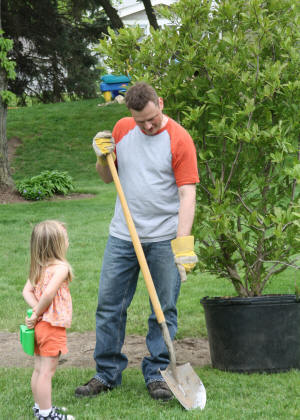|

Plant a Tree and Make a Difference
By Melinda Myers
[April 12, 2025]
Trees provide many benefits to the environment and
our health and well-being. These long-lived members of our
landscapes and communities provide shade, help reduce energy costs,
clean the air we breathe, prevent soil erosion and stormwater
runoff, and attract and provide homes for birds and pollinators.
National Arbor Day, celebrated on the last Friday of April,
recognizes the important role trees play in our environment.
Spending time among the trees also helps boost our immune system.
Studies reveal that tree-filled landscapes help decrease domestic
conflict, as well as aggression and violence at schools. A mindful
walk through the woods, known as forest bathing, helps reduce blood
pressure and stress. It increases focus and energy levels, improves
sleep, and much more. |
|
When planting new trees make sure to select one that
will fit in the space when mature and thrive in the growing
conditions. Plant tags and catalog descriptions can provide you with
this important information. Consider including trees that provide
multiple seasons of beauty with flowers, fruit, fall color, and
form. Look for those that also support birds and pollinators as they
deliver many other environmental benefits.
Select a planting location away from overhead and underground
utilities to avoid future conflicts. Avoid plants that eventually
could grow into wires or structures that may interfere with
utilities and power transmission, creating a real hazard.
Always call 811 at least three business days before putting the
first shovel in the ground. When your request is received, this
non-profit group contacts all the appropriate underground utilities.
The utilities’ locators will then mark the location of the
underground utilities in your work area. Contacting them first
reduces the risk of injury, the inconvenience of accidentally
knocking out power, cable, or other utilities, and the potential
cost incurred to repair a utility you damage when skipping this
step.
Once the location is cleared, you’re ready to start planting. Locate
the tree’s root flare (where the roots curve away from the trunk) by
gently pulling the soil away from the trunk as needed. Dig a hole
two to five times wider and the same depth as the distance from the
root flare to the bottom of the root ball. Set the tree in the hole,
carefully remove it from the container, and loosen or prune off any
circling roots. Cut back burlap and wire baskets when planting
balled and burlapped trees.
Plant the tree so the root flare is even with or slightly above the
soil surface. Roughen the sides of the hole and backfill with the
existing soil. Water thoroughly and spread a two-to-three-inch layer
of mulch over the soil surface, keeping the mulch away from the tree
trunk.
[to top of second column] |

Continue watering throughout the growing season, the
following year, and as needed once established. Check the soil
moisture and thoroughly water the root ball and surrounding soil
when the top few inches of soil are crumbly and slightly moist.
Apply ten gallons of water for every inch of the trunk’s diameter at
four- and one-half feet high.
If you don’t have room for your own tree, contact your municipality,
park, or nature center. Many organizations are looking for
volunteers to help plant and care for trees which will benefit even
more people in your community.
Melinda Myers has written more than 20 gardening books,
including the Midwest Gardener’s Handbook, 2nd Edition and Small
Space Gardening. She hosts The Great Courses “How to Grow Anything”
instant video and DVD series and the nationally syndicated Melinda’s
Garden Moment TV & radio program. Myers is a columnist and
contributing editor for Birds & Blooms magazine and was commissioned
by Summit for her expertise to write this article. Myers’ website is www.MelindaMyers.com.
[Photo courtesy of MelindaMyers.com]
 |